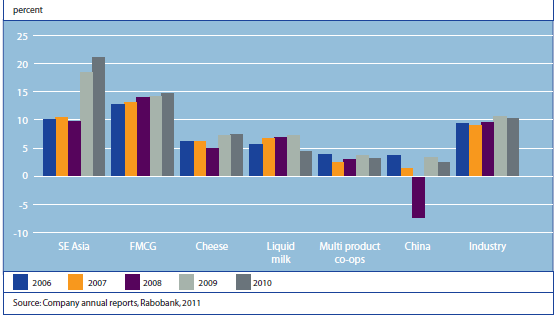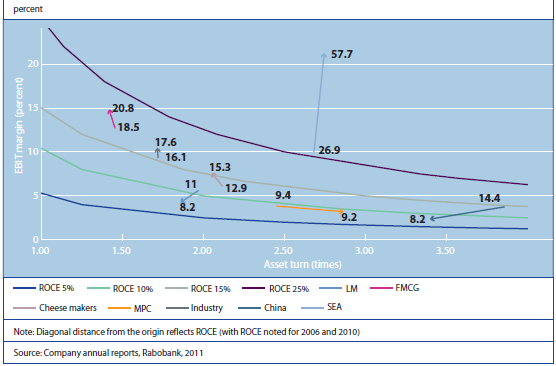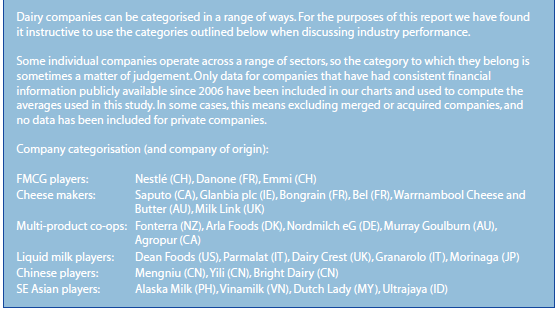



Global Dairy Outlook: Processors Struggling
The operating environment for dairy processors has changed substantially in the last four years. This is one of the key conclusions coming out of the Rabobank Food & Agribusiness Research and Advisory report, “Global Dairy Outlook: Show me the money”.Not only have the costs of raw milk and commodity ingredients more or less doubled, they have exhibited unprecedented volatility. Economic and financial conditions have been highly unpredictable and, in some regions, unfavourable; retailers have been aggressively pushing private label products, partly in response to the economic downturn.
These changes have presented major challenges for the world’s dairy processors in terms of operating margins, efficient use of assets and return on invested capital.
Margins have generally improved but experience varies
Short-term margin defence proved extremely challenging for dairy processors in recent years. As prices soared in 2008, followed by the collapse of the global economy, 70 percent of companies saw a significant deterioration in their EBIT margins. However, by 2010 EBIT margins were higher than had been evident before the price boom.
Experience has varied considerably within the sector. Those that escaped margin issues in 2008 were almost exclusively FMCG players or export-oriented cooperatives, who were able to benefit from rising prices. In contrast, in 2009 these cooperatives were faring worse, and the players who had taken a hit from the rising prices improved their EBIT margins again. Companies in South East Asia, FMCG players and cheese makers have seen a significant improvement in margins since 2006, while the liquid milk sector and Chinese dairy companies saw margins deteriorate over the same period (see Figure 4.1).
Despite a structural increase in raw material costs, and the pain experienced in 2008, the industry has been remarkably successful in defending and improving margins over the medium term. Three main strategies account for this success: passing on price increases to consumers, trading up to higher value product lines or markets, and reducing operational costs.
Sustaining efficient asset use has proved more difficult
Dairy processors have found it harder to maintain efficient asset use since prices took off in 2008. Higher commodity prices pushed up working capital requirements as the value of debtors and inventories rose, and companies who built new plants or bought brands or businesses have had to take greater care to achieve appropriate returns on their investments. With the exception of South East Asian companies and multiproduct co-ops, all groups have seen a decline in the asset turns over this period (see Figure 4.2).
Most earning a higher return on capital employed than before the boom
The combination of EBIT margins and asset turnover effectively determines the rate of return a company derives from the capital employed in the business. At the industry level, the improvement in EBIT margins achieved by many companies has offset a smaller deterioration in asset efficiency, with industry return on capital employed (ROCE) increasing since 2006 (see Figure 4.3).
EBIT Margins by Sector, 2006-2010

Experience has varied by sector
While dairy companies have generally managed recent problems extremely well, the experience varies considerably from sector to sector and indeed, even by company within a sector.
Fast-moving consumer goods players
FMCG players have proved to be the best equipped to ride commodity price volatility, with all players in this category expanding margins through the initial year of the commodities boom and global financial crisis.
On a multi-year basis, they have managed to increase margins significantly, more than offsetting a small decline in asset turns, increasing their ROCE by more than 200 percentage points since 2006 as a result. In doing so, they have increased the performance gap between themselves and the rest of the pack (with the exception of the South East Asian companies).
A number of factors have contributed to this success. Since FMCGs have focused for many years on improving their value-add, raw material costs account for a lower share of their sales than for most other dairy businesses, which cushioned the impact of the first commodity boom. The fact that they had also been refining their product portfolios to focus on A brands left FMCGs less exposed to private label competition.
Over the period from 2006 to 2010, FMCG players continued to further trade up. As many of them are major multinational businesses, they have the ability to invest heavily in product innovation and development and then roll these innovations out over a broad market base. They have also invested heavily in rapidly growing, developing markets such as South East Asia and limited their exposure to maturing products and regions, building lead positions in the most profitable markets. Finally, FMCG players have successfully stripped costs from their businesses to defend EBIT margins.
Asset Turn by Sector, 2006-2010

Sector Performance, 2006 vs. 2010

Cheese makers
Cheese makers were hit hard in 2008. EBIT margins declined as they battled to pass on cost increases, and asset turns shrank as sales volumes fell and inventories jumped. But in general, they have managed not only to recover from this difficult period, but also to improve on their position prior to the price boom and global financial crisis. Between 2006 and 2010, rising EBIT margins have more than offset reduced asset turns, driving an improvement in ROCE of 160 percentage points.
This medium-term success has been influenced by a number of factors. Several companies have reduced operating costs by investing in larger, more efficient scale plants in recent years, and have taken major steps to improve their logistics and supply chain. The industry has also benefitted from ongoing efforts to make better use of whey by-products and from the surge in whey product prices since 2007. Market power and/or cost efficiency have improved as a result of the sound planning and execution of acquisitions (and in some cases, divestments).
Multi-product cooperatives
The raison d’être of cooperatives is to maximise farmgate returns, which means that most are unlikely to ever see a significant leap in their EBIT margins (which includes the cost of milk bought from their members). Put simply, most market upside belongs to the members. Equally, most cooperatives see market downside as belonging to members, which generally insulates the cooperatives from margin downturns over time.
Although the EBIT margins of multi-product cooperatives were somewhat lower in 2010 than in 2006, this was largely offset by increased asset turns achieved through higher sales revenues from existing plants. ROCE changed little as a result.
Liquid milk players
The liquid milk sector has perhaps been the most challenged sector across a range of countries in the last four years. The sector is at the sharp end of several problems facing the dairy industry as a whole, including rising costs, rising retail power, increased private-label penetration, maturing markets and constraints on innovation.
Categorisation of Dairy Companies

Financial Metrics Defined

On the cost front, raw milk accounts for a high share of sales value, giving the sector significant exposure to rising milk prices. In most countries, the share of liquid milk sold via traditional retail channels is higher than for other product lines, leaving processors to negotiate margins with extremely powerful retail customers. Since milk is a heavily commoditised product with ‘traffic building’ potential for retailers, private label penetration is high and rising in many countries. Retailers are therefore willing to periodically drop their own brand prices to loss-making levels to attract customers.
In respect of market maturity, liquid milk sales are typically the first to start slowing in developing markets (currently evident in large Chinese cities), and the first to decline when markets become saturated (evident in the US and Japan in recent years). Falling sales volumes make it extremely difficult to achieve efficient asset utilisation. Strict regulation on what is classified as milk means that in most countries processors have little room to manoeuvre when it comes to altering milk to improve its functionality, nutritional profile or flavour, which limits their capacity to innovate.
As with all dairy product categories, economic conditions in western markets have also been a major issue. Companies operating in this difficult space have adopted a range of survival strategies. Several have pursued industry consolidation to reduce costs and increase their market power while others have closed or divested loss-making business lines. Some companies have moved towards a ‘cost plus’ model in their dealings with major retailers and most have either bought or built businesses in alternative supply chain product lines (e.g. organics) or competing product lines (e.g. soy, almond and rice milks).
While some players have made good progress and seen improvements in their financial returns in recent years, most have seen a decline in their EBIT margins and stable or deteriorating asset turns, with the sector as a whole seeing a lower ROCE in 2010 than before the commodities price boom. This decline has pushed returns even below those of multi-product cooperatives, which are not truly focused on profit maximisation.
Chinese companies
Despite the strong growth story China has represented for the global dairy industry in recent years, it has proved a difficult operating environment for the three main domestic processors.
The multifaceted effects of the melamine crisis have been well documented, and their intense impact on margins in 2008 are evident. It is less well known that processors were facing a gradual decline in their margins and asset use both before and after the crisis period, with 2010 ROCE more than 620 basis points below 2006 levels—and is now among the lowest of any of the categories we have addressed.
While many product categories continue to show exceptional growth, several key cities have seen a slowing growth in liquid milk sales (a product category these players are highly exposed to). These players also face strong competition in a market where growth is slowing and where costs are rising sharply for both local and imported milk. Investment costs are also rising, as a result of supply chain redevelopment (including farm construction) after the melamine crisis, and significant investment in large, modern processing plants, some of which are not yet being fully utilised.
South East Asian players
Perhaps the darlings of the global dairy industry in the last four years have been a collection of South East Asian companies. In two respects this might seem surprising. First, most of the players in this region rely heavily on imported dairy commodities, which have seen significant price rises and volatility. Second, low value-add products make up a high share of their sales in comparison to many players in western markets. Nonetheless, ROCE almost doubled in the four years to 2010, and was well above that achieved by any other category of companies.
The drivers of this success differ somewhat from company to company, but include the effective use of high and rising domestic market share to leverage increased margins, cost reduction strategies, the successful development and marketing of lower cost product lines when required, and trading up to higher margin products where it makes sense (including highly successful products such as growing-up milk).
Getting in the zone
Since 2006, the dairy processing sector has performed remarkably well in defending and then improving its position in the face of a structural shift in its costs base, rising volatility and, in many cases, a hostile economic environment. The processing sector has been able to pass on some of their cost increases to retailers or ingredient buyers, assisted in part by the compelling nature of the commodities price boom. The price boom and the financial crisis were major wake-up calls which forced dairy companies to re-evaluate their businesses, to restructure and reposition where required, and to increase their focus on working capital management. The challenge in the coming years will be to maintain and improve on this performance as the operating environment continues to evolve.
The next five years will provide a range of opportunities for dairy processors. But it will be vital for companies to position themselves correctly to maximise their chances of success while managing risk. For companies based in developed countries, opportunities offshore warrant attention in terms of the slowing of growth at home, the likely volume growth on offer in other markets and, in some cases, the ROCE being earned abroad. Security of supply will remain an issue for many, but the modest return on assets earned on-farm falls below the bar most corporates would set for themselves for investments, limiting the appeal of vertical integration for processors on a purely financial basis.
Cheese players are entering a new era, which requires careful positioning. In the US and the EU, domestic cheese market growth will be slow in volume terms, with offshore opportunities attractive, but not large enough for all. The drive for efficiency, differentiation and value-adding will all become increasingly important in such maturing markets. The strategic value of whey pools is rising rapidly, justifying a re-evaluation of ingredient production and sourcing strategies.
Ongoing challenges in liquid milk markets warrant revisiting current strategies in mature markets and considering what challenges may be coming in less mature markets.
More generally, there is a risk that we will see an increasing gap open up between the returns of FMCG companies and those of others, given the strong foothold of FMCG companies in product categories, parts of the supply chain and regions that are expected to grow strongly.
March 2012
Further Reading
| |
- | Go to our previous news item on this story by clicking here. |


